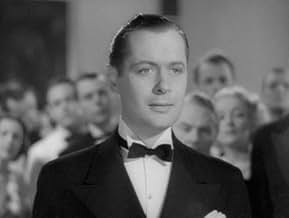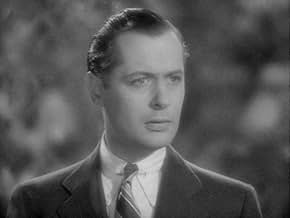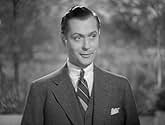A society girl tries to reform her playboy husband by making him jealous.A society girl tries to reform her playboy husband by making him jealous.A society girl tries to reform her playboy husband by making him jealous.
- Awards
- 3 wins total
Charles Ruggles
- Edgar
- (as Charlie Ruggles)
Joan Fontaine
- Caroline
- (as Joan Burfield)
John David Horsley
- Duffy
- (as David Horsley)
E.J. Babille
- Desk Clerk
- (as E.J. Babiel)
Jean Acker
- Nightclub Extra
- (uncredited)
Gertrude Astor
- Nightclub Extra
- (uncredited)
Clem Beauchamp
- Drunk
- (uncredited)
Brooks Benedict
- Joe Williams - Bar Owner
- (uncredited)
Veda Buckland
- Marcia's Maid
- (uncredited)
Featured reviews
Though the careers of Robert Montgomery, Joan Crawford, and her husband at the time, Franchot Tone's respective careers were not hurt by films like No More Ladies, this was the kind of stuff all three of these players were looking to get out of.
There was a truism at MGM back in its heyday. For films where the men wear tuxedos you first get Robert Montgomery. If he turns it down get Franchot Tone. If it's bad enough for Tone to turn it down God help him, Robert Young is stuck with it. So knowing the pecking order and knowing the billing, you can guess who Crawford winds up with.
Robert Montgomery plays another of those irrepressible womanizing playboys who's sowed enough wild oats to qualify for a farm subsidy. He's decided to settle down with society girl Joan Crawford who has certain ideas about infidelity and how wrong it is. Montgomery behaves at first, but when he uses their perpetually inebriated friend Charlie Ruggles as an alibi that doesn't hold up, Crawford decides on some revenge with Franchot Tone.
No More Ladies is harmless enough and when Edna May Oliver as Joan's grandmother is on the screen, always entertaining. But it was the stuff that MGM was grinding out in its dream factory. It was a case of Montgomery and Tone look great in tuxedos so cast them as urban playboys.
Well, both of them did look great, Louis B. Mayer wasn't wrong about that.
There was a truism at MGM back in its heyday. For films where the men wear tuxedos you first get Robert Montgomery. If he turns it down get Franchot Tone. If it's bad enough for Tone to turn it down God help him, Robert Young is stuck with it. So knowing the pecking order and knowing the billing, you can guess who Crawford winds up with.
Robert Montgomery plays another of those irrepressible womanizing playboys who's sowed enough wild oats to qualify for a farm subsidy. He's decided to settle down with society girl Joan Crawford who has certain ideas about infidelity and how wrong it is. Montgomery behaves at first, but when he uses their perpetually inebriated friend Charlie Ruggles as an alibi that doesn't hold up, Crawford decides on some revenge with Franchot Tone.
No More Ladies is harmless enough and when Edna May Oliver as Joan's grandmother is on the screen, always entertaining. But it was the stuff that MGM was grinding out in its dream factory. It was a case of Montgomery and Tone look great in tuxedos so cast them as urban playboys.
Well, both of them did look great, Louis B. Mayer wasn't wrong about that.
Broadway must have had dozens of these drawing room comedies featuring rich, well-dressed people speaking snappily to one another. I say "must have" because Hollywood seems to have adapted all of them. "No More Ladies" is yet another one, and for my money, it's pretty routine. Joan Crawford is a rich girl in love with a cad, played by Robert Montgomery. They marry and he's still a cad. In fact, instead of going to their country house one weekend, he delays his trip and has a dalliance with a woman named Therese. He admits this when he finally shows up in the country. He has little choice when he learns that his alibi, Charlie Ruggles, is actually at the country home. In retaliation, Crawford invites an old beau and a couple of ex-girlfriends to a huge party.
The dialogue is witty, the clothes are glamorous, the apartment and house are sumptuous, and the performances are very good. Montgomery was always perfect in these roles, and Crawford is attractive and spars with Montgomery well. Edna Mae Oliver is superb as always. Charles Ruggles plays a somewhat annoying drunk. Gail Patrick, who became Gail Patrick Jackson and produced "Perry Mason," having married Erle Stanley Gardner's agent, does very well as the pretty other woman.
This is one of those films where one asks, so why wasn't I crazy about it? The only reason is that there was a sameness about it and nothing really to differentiate it - including the cast - from all the other light, romantic comedies. It's no wonder that Robert Montgomery fought so hard to make "Night Must Fall." He was incredibly bored with these roles. It's understandable.
The dialogue is witty, the clothes are glamorous, the apartment and house are sumptuous, and the performances are very good. Montgomery was always perfect in these roles, and Crawford is attractive and spars with Montgomery well. Edna Mae Oliver is superb as always. Charles Ruggles plays a somewhat annoying drunk. Gail Patrick, who became Gail Patrick Jackson and produced "Perry Mason," having married Erle Stanley Gardner's agent, does very well as the pretty other woman.
This is one of those films where one asks, so why wasn't I crazy about it? The only reason is that there was a sameness about it and nothing really to differentiate it - including the cast - from all the other light, romantic comedies. It's no wonder that Robert Montgomery fought so hard to make "Night Must Fall." He was incredibly bored with these roles. It's understandable.
Since I like both Robert Montgomery and Franchot Tone, and I also like Joan Crawford better when she's younger, it was an easy guess that I'd like the romantic comedy No More Ladies. As it turned out, the film was far more of a drama than I thought, but the biting quips kept flying often enough to qualify it as a dark comedy.
Joan starts the film hopelessly in love with Robert Montgomery. He's handsome and enormously charming and can talk his way out of any mistake, whether it's tardiness or infidelity. Joan knows exactly what type of cad he is and yet she wants to marry him anyway. After they're married, she expects him to keep his roving eye in check, but he doesn't. Depending on whether or not you like Robert Montgomery will probably be the deciding factor for you as to whether or not you like the overall film. If you think he's a terrible cad who has no excuse of losing his will-power whenever a skirt walks past, you'll want Joan to go to Reno and get over him. If you think he has appallingly low self-control but really does love his wife and just needs to be watched like a puppy, you won't want her to drive to Reno. You might want her to team up with her supportive grandmother, Edna May Oliver, and throw a party akin to A Little Night Music or Smart Woman. You might want her to use her handsome friend Franchot Tone to make her husband jealous. It's a little eerie to watch Joan and Franchot's scenes together since this movie was made before they were married and most of Franchot's dialogue consists of bitter complaints about his ex-wife. However, they're both young and pretty, and it's nice to see them during happier times. It's also nice to see Joan's beautiful dresses, designed by the very talented Adrian.
Joan starts the film hopelessly in love with Robert Montgomery. He's handsome and enormously charming and can talk his way out of any mistake, whether it's tardiness or infidelity. Joan knows exactly what type of cad he is and yet she wants to marry him anyway. After they're married, she expects him to keep his roving eye in check, but he doesn't. Depending on whether or not you like Robert Montgomery will probably be the deciding factor for you as to whether or not you like the overall film. If you think he's a terrible cad who has no excuse of losing his will-power whenever a skirt walks past, you'll want Joan to go to Reno and get over him. If you think he has appallingly low self-control but really does love his wife and just needs to be watched like a puppy, you won't want her to drive to Reno. You might want her to team up with her supportive grandmother, Edna May Oliver, and throw a party akin to A Little Night Music or Smart Woman. You might want her to use her handsome friend Franchot Tone to make her husband jealous. It's a little eerie to watch Joan and Franchot's scenes together since this movie was made before they were married and most of Franchot's dialogue consists of bitter complaints about his ex-wife. However, they're both young and pretty, and it's nice to see them during happier times. It's also nice to see Joan's beautiful dresses, designed by the very talented Adrian.
This film is not entirely dismal. Robert Montgomery is light and smooth as the playboy who nails anyone he wants, including the wives of his friends. The long list includes Gail Patrick, who plays Carole Lombard's nasty older high society sister in "My Man Godfrey". In this bizarro world film, she is a banjo playing bar fly. Anyway, before RM and Joan Crawford get married, he is told not to go into her room because she is in bed. Response: "Since when is a lady in bed an object of repugnance?" Joan runs around in sharp designer outfits, and restrains herself from chewing the scenery - much. In short, some snappy dialogue amid the heavy drinking and innuendos. To quote someone clever, "marriage is the death of hope and the birth of despair." BC
For sporadic moments of amusement "No More Ladies" is perfectly satisfactory. It has the MGM lusciousness and gleam that the other studios envied. Note the great looking costumes on Joan Crawford, Joan Fontaine, and Gail Patrick wear. The sophistication is showed by the ho-ho-ho jokes that are dropped by the likes of Crawford, Robert Montgomery, Franchot Tone, and Edna Mae Oliver. This is the type of film that has the hero with a name like "Sherry". People go to night clubs, and to fancy restaurants, and take drives in Central Park at night (it is, after all, the 1930s).
The film is a bore - it occasionally amuses because of the cast, but the dialog is brittle for the sake of brittle. It is Noel Coward's world but not the real wit he brought - Coward's best plays show a streak of harshness and mutual malevolence mixed with affection in his couples like Amanda and Elyot in "Private Lives". They also tend to be smarter than the characters here.
Also the characters are not all that amusing nowadays. Montgomery's cousin is Charlie Ruggles, who is constantly drunk. Ruggles is a favorite comedian to me, but here he was dull. Reginald Denny is around as a British version of Ralph Bellamy - an available alter-suitor to Montgomery for Crawford, and while Denny is elegant (in a skittish sort of way) he is not at all as amusing as Ralph Bellamy was in "His Girl Friday" or The Awful Truth".
After watching this film I stopped to consider the three leads. Montgomery was typecast for most of the 1930s (except for an occasional film like "The Big House") as a happy, amoral socialite. Nobody really played the upper-crust cad as well as he did, but he got bored by it, and fought for meatier parts - and after his brilliant Danny in "Night Must Fall" he got them. Crawford reveled in parts like the hard-working lower class girl fighting her way to happiness, but she did many "socialite" parts as well. Along came "The Women", and she played a villainous social climber. After that came the really hard-boiled darker parts of the 1940s and 1950s like "Mildred Pierce" and "A Woman's Face" and "Flamingo Road". Tone, in 1935, would start having roles like Bryam in "Mutiny On The Bounty" - like Montgomery he would play his wealthy cads, but he would be able to step into nastier, meatier roles like "The Phantom Lady" and "The Man On The Eiffel Tower". When one talks to their fans about the great work of these three actors, it is the films where they played characters with demons after them that are recalled. Few really recall a piece of meaningless cotton candy like "No More Ladies" regarding any of them.
The film is a bore - it occasionally amuses because of the cast, but the dialog is brittle for the sake of brittle. It is Noel Coward's world but not the real wit he brought - Coward's best plays show a streak of harshness and mutual malevolence mixed with affection in his couples like Amanda and Elyot in "Private Lives". They also tend to be smarter than the characters here.
Also the characters are not all that amusing nowadays. Montgomery's cousin is Charlie Ruggles, who is constantly drunk. Ruggles is a favorite comedian to me, but here he was dull. Reginald Denny is around as a British version of Ralph Bellamy - an available alter-suitor to Montgomery for Crawford, and while Denny is elegant (in a skittish sort of way) he is not at all as amusing as Ralph Bellamy was in "His Girl Friday" or The Awful Truth".
After watching this film I stopped to consider the three leads. Montgomery was typecast for most of the 1930s (except for an occasional film like "The Big House") as a happy, amoral socialite. Nobody really played the upper-crust cad as well as he did, but he got bored by it, and fought for meatier parts - and after his brilliant Danny in "Night Must Fall" he got them. Crawford reveled in parts like the hard-working lower class girl fighting her way to happiness, but she did many "socialite" parts as well. Along came "The Women", and she played a villainous social climber. After that came the really hard-boiled darker parts of the 1940s and 1950s like "Mildred Pierce" and "A Woman's Face" and "Flamingo Road". Tone, in 1935, would start having roles like Bryam in "Mutiny On The Bounty" - like Montgomery he would play his wealthy cads, but he would be able to step into nastier, meatier roles like "The Phantom Lady" and "The Man On The Eiffel Tower". When one talks to their fans about the great work of these three actors, it is the films where they played characters with demons after them that are recalled. Few really recall a piece of meaningless cotton candy like "No More Ladies" regarding any of them.
Did you know
- TriviaBig-screen debut of Joan Fontaine (listed as Joan Burfield).
- GoofsWhen Sherry and Fanny are talking in front of the fireplace, from one scene to the next his position changes back and forth. First he's standing and facing Fanny, who is sitting as they talk; then he is to her side, kneeling on a sofa bench with his back to her and leaning on the fireplace hearth. Then he is back opposite her, standing and facing her as they talk; then he's back kneeling on the sofa and leaning on the hearth. Then he's once again standing and facing Fanny.
- Quotes
Oliver Allen: Look here, you can't go up there--she might be in bed!
Sheridan 'Sherry': Since when has a lady in bed been an object of repugnance?
- ConnectionsFeatured in Joan Crawford: The Ultimate Movie Star (2002)
- SoundtracksAll I Do Is Dream Of You
(1934) (uncredited)
Music by Nacio Herb Brown
Lyrics by Arthur Freed
Played on banjo by Arthur Treacher and
Sung by Gail Patrick at the party
Details
Box office
- Budget
- $765,000 (estimated)
- Runtime
- 1h 20m(80 min)
- Color
- Aspect ratio
- 1.37 : 1
Contribute to this page
Suggest an edit or add missing content



































